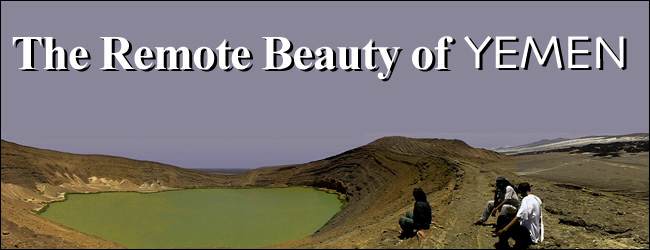 ©ViewZone Expedition 2001
|
|
ViewZone and the Volcano
Long ago, thundering volcanoes heaved up from the Earth's floor, creating mountains of black and red obsidian. Today, the remains of those ancient volcanoes rise up from the dunes all over Yemen. We pulled off the coastal highway outside Bir'Ali at high noon. Our guide, Ahmed, looked for a particular outcrop of rock and signaled Abdul to stop the Land Cruiser. "This is it. We must now walk." Ahmed beckoned us to base of a steep and rocky hill. Climbing was extremely difficult because of the loose stones and the oppressive heat. When we finally reached the top, the view was surreal. We were perched atop a large volcanic crater, filled with rainwater and colored green by algae and minerals. The scene was both beautiful and stark. There were no signs or paths to this scenic vista and it appeared to be unknown to most of the passers-by on the highway below. Our eyes followed the curve of the earth, traveling from open sea to vast desert, stopping only to size up other dark, sleeping giants in the distance. Bir'Ali |
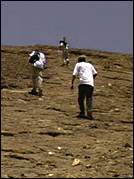
|
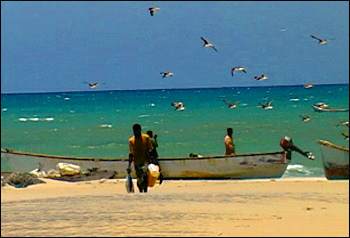
|
Bir'Ali is a small fishing village on the Southern coast of Yemen, on the warm Arabian Ocean. It was once a harbor of lesser significance than Al Mukalla and now has been completely abandoned and reduced to a modest fishing village. Wooden structures with tin roofs form a town "center" where there are the usual shai restaurants and some of the freshest and most delicious fish and crab. |
|
We bought some shellfish from the fisherman and had them cooked at a small restaurant. The people were friendly, as always, but we noticed some veiled women with children who approached us and begged for money. "These are Somali refugees," our guide explained. "They come here with their children to escape the war in Africa. It is very sad." We gave them some food and some cash. Nasser explained that such giving is a requirement of Islam. But we would have helped them anyway. As it turned out, we all left the small restaurant with a full stomach. |
|
Nagub Al Hajar
|
|
At the modern town of May-fah, we traded the asphalt road for a gravel one. We were eventually on sand and located the ruins of Old May-fah. The first oasis on the main route for frankincense caravans heading West from the port city of Al Mukalla, Old May-fah supplied vital water and shelter. It also had its own suqs or markets. Old May-fah was the departure point for three wealthy kings named Balsar, Balthasar and Kasper -- the Three Wise Men of the Bible -- who followed the bright star in the sky to the infant Jesus over two millennia ago.
We were able to locate the main palace and took some shelter from the sun. Atop a high stone tower at the South gate Ahmed pointed to the familiar letters of a faint Sabaean inscription. Here was our treasure! We copied the text carefully and translated the script later with the laptop. The Queen of Sheba, Bilquis, made Naqb Al-Hajar her home for a short while during the emigration of the Sabaeans to Ethiopia in about 900 B.C. It was in hope of finding evidence of this occupation that we had left the beaten path. We were not disappointed. The inscription we copied revealed that the Queen's exodus was painfully sad and that her nation weeped for her sorrow. |
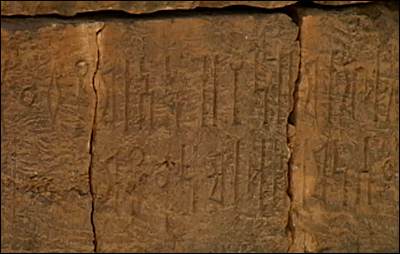
|
" We have arrived from the sands to pray for the mound, O Lord. The horizon held beauty so we stopped the caravan. Here, where none of this prophesy is known, we do not speak of the Son; the mound. We plan to return across this border. We leave our insignia. The Mother understands the evil about to arrive. The Son of Jinn, the Lord, is under the ground. Say nothing. She cried flying over the ocean. No spirit shall defile the only Son of the Jinn. You are beautiful to me. Know this, O Lord." |
| Transliteration [above] is from a Sabaean inscription found in the remaining walls of the old city of May'Fah. The ViewZone team recorded the inscription with digital imaging equipment and obtained the translation using a proto-semitic dialect. |
|
I gathered a handful of pebbles, momentos of my brush with the Bible.
Gulping down the water I had left in the car, I was happy in the shade of the car's interior. We were headed West to a cooler destination. Soon we would be climbing to over nine thousand feet above sea-level-- in one day.
|
Previous Page || ViewZone || --next-->
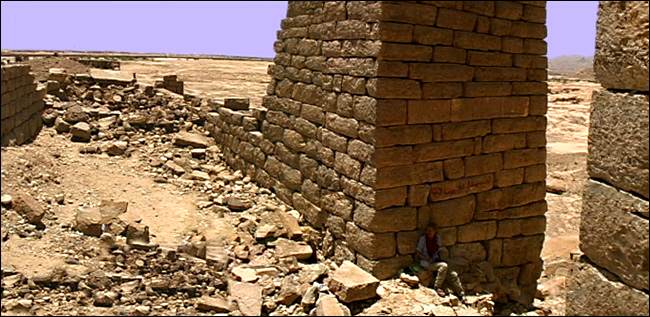
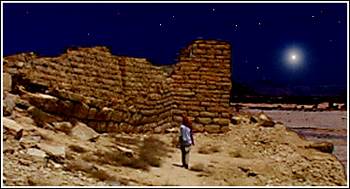 We used a compass and noted the direction where the bright star would have been seen from this ancient site. One could easily imagine the evening star, illuminating the desert night while camels were being packed with incense and spices for the trip. Today, this old caravanserai had been reduced by wind and sand to a few stone walls and rubble. Most of the city lies undisturbed and unexcavated. The remote location guarantees its preservation.
We used a compass and noted the direction where the bright star would have been seen from this ancient site. One could easily imagine the evening star, illuminating the desert night while camels were being packed with incense and spices for the trip. Today, this old caravanserai had been reduced by wind and sand to a few stone walls and rubble. Most of the city lies undisturbed and unexcavated. The remote location guarantees its preservation.